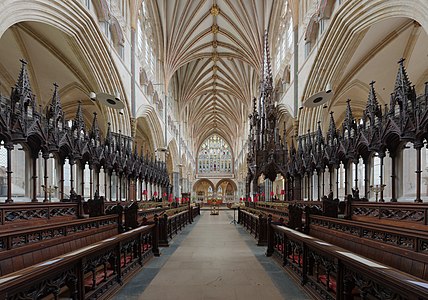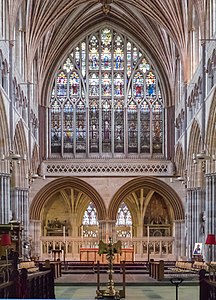Exeter Cathedral
| Exeter Cathedral | |
|---|---|
| Cathedral Church of Saint Peter in Exeter | |
 | |
| 50°43′21″N03°31′47″W/ 50.72250°N 3.52972°W | |
| Location | Exeter,Devon |
| Country | United Kingdom |
| Denomination | Church of England |
| Previous denomination | Catholic |
| Tradition | Anglo-Catholic |
| Website | www |
| Architecture | |
| Functional status | Active |
| Previous cathedrals | 2 |
| Style | Norman,Gothic |
| Years built | 1112–1400 |
| Specifications | |
| Length | 383 feet (117 m)[1] |
| Bells | 15 (12 + 2 + Bourdon)[2] |
| Tenor bell weight | 3,684 kilograms (8,122 lb)[2] |
| Administration | |
| Province | Canterbury |
| Diocese | Exeter(since 1050) |
| Clergy | |
| Bishop(s) | Robert Atwell |
| Dean | Jonathan Greener |
| Precentor | James Mustard |
| Canon Chancellor | Deborah Parsons |
| Canon(s) | Cate Edmonds |
| Canon Treasurer | Chris Palmer |
| Laity | |
| Director of music | Timothy Noon |
Exeter Cathedral,properly known as theCathedral Church of Saint Peter in Exeter,is anAnglicancathedral,and the seat of theBishop of Exeter,in thecityofExeter,Devon,inSouth West England.The present building was complete by about 1400 and has several notable features, including an early set ofmisericords,anastronomical clockand the longest uninterrupted medieval stonevaulted ceilingin the world.
History[edit]
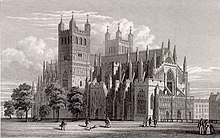



The site where Exeter Cathedral was constructed was home toRomanbuildings. A legionary fortress was constructed between 50–75 AD. A Roman bathhouse was discovered in 1971.[3]
The founding of thecathedralatExeter,dedicated toSaint Peter,dates from 1050, when the seat of thebishopofDevon and Cornwallwas transferred fromCreditonbecause of a fear of sea-raids. ASaxonminster already existing within the town (and dedicated toSaint Maryand Saint Peter) was used byLeofricas his seat, but services were often held out of doors, close to the site of the present cathedral building.
In 1107William Warelwastwas appointed to the see, and this was the catalyst for the building of a new cathedral in theNormanstyle. Its official foundation was in 1133, during Warelwast's time, but it took many more years to complete.[4]Following the appointment ofWalter Bronescombeas bishop in 1258, the building was already recognised as outmoded, and it was rebuilt in theDecoratedGothicstyle, following the example ofSalisbury.However, much of the Norman building was kept, including the two massive square towers and part of the walls. It was constructed entirely of local stone, includingPurbeck Marble.The new cathedral was complete by about 1400, apart from the addition of thechapter houseandchantry chapels.
Like most English cathedrals,Exetersuffered during theDissolution of the Monasteries,but not as much as it would have done had it been a monastic foundation. Further damage was done during theCivil War,when thecloisterswere destroyed. Following the restoration ofCharles II,a newpipe organwas built in the cathedral byJohn Loosemore.Charles II's sisterHenrietta Anne of Englandwas baptised here in 1644. In 1650 an independent church was meeting in the cathedral and this small church caused upset when the minister "excommunicated"Susanna Parr.[5]
During theVictorian era,some refurbishment was carried out byGeorge Gilbert Scott.As a boy, the composerMatthew Lockewas trained in the choir of Exeter Cathedral, underEdward Gibbons,the brother ofOrlando Gibbons.His name can be found scribed into the stone organ screen.

During theSecond World War,Exeter was one of the targets of a German air offensive against British cities of cultural and historical importance, which became known as the "Baedeker Blitz".On 4 May 1942 anearly-morning air raid took place over Exeter.The cathedral sustained a direct hit by a large high-explosive bomb on the chapel of St James, completely demolishing it. The muniment room above, three bays of the aisle and two flying buttresses were also destroyed in the blast. The medieval wooden screen opposite the chapel was smashed into many pieces by the blast, but it has been reconstructed and restored.[6]Many of the cathedral's most important artefacts, such as the ancient glass (including the great east window), the misericords, the bishop's throne, the Exeter Book, the ancient charters (ofKing AthelstanandEdward the Confessor) and other precious documents from the library had been removed in anticipation of such an attack. The precious effigy ofWalter Branscombehad been protected by sand bags.[7]
In July 2023,The Methodist Recorderreported that the cathedral chapter signed a sharing agreement between it and Mint Methodist Exeter for shared use of the Lady Chapel.[citation needed]
Architecture[edit]


The Norman cathedral construction began in 1112, presumably at the east end and was consecrated in 1133, by which date the choir, transept and first two bays of the nave were probably complete. As detailed above, remains of the Norman building can be seen in the massivetransept towers.By 1160 the nave and west front were complete, and a cloister andchapter housewere added between 1180 and 1244.
During the 1270s, a new project began to replace the entire east end, starting with the east end chapels. This work is documented by a very extensive series of fabric rolls.[8]Work advanced slowly, with the retrochoir, presbytery and choir being built in the 1290s. The original choir elevation had two storeys, but was later modified to three, presumably after the arrival of Master Roger in 1297.Master Thomas of Witneywas engaged in 1316 to design the choir furnishings, then becamemaster masonand stayed at Exeter until 1342.
By 1328 the church was complete to the first two bays of the nave, where a design change in thevaultsis visible. During Master Thomas of Witney's time the east cloister walk was begun (1318–25) and the nave, west front and north cloister walk were probably completed (c.1328-42). That the present west front is on the same site as the Norman predecessor is indicated by the narrowing of the nave bays towards the west, squeezed to meet an existing feature.
The image screen across the west facade and the chantry chapel ofBishop Grandissonlocated within the west front were probably designed byWilliam Joy,who succeeded Witney as master mason in 1342 but seems to have died in 1347, possibly from the Black Death. From 1377 to 1414 the east, south and west cloister walks were finished by Master Robert Lesyngham, who probably also designed the great East Window (1390–92).
The architecture of Exeter Cathedral at first appears remarkably harmonious with the continuous run oftierceron vaultsextending from west to east.[9]Although the bays are irregular in size, the plan is throughout based on a division into ninths. There is also a wonderful array of tracery designs in the clerestorey windows.[10]More detailed analysis nevertheless reveals a number of changes, including the decision to adopt a three-storey facade with atriforiummore typical of cathedrals than the previous two-storey design. 3-D scanning of the vaults has also revealed numerous changes to the curvatures of the ribs.[9]
Notable features[edit]
Notable features of the interior include the misericords, the minstrels' gallery, the astronomical clock and the organ. Notable architectural features of the interior include the multiribbed ceiling and the compound piers in the nave arcade.[11]
The 18-metre-high (59 ft)bishop's thronein thechoirwas made from Devon oak between 1312 and 1316; the nearby choir stalls were made byGeorge Gilbert Scottin the 1870s. The Great East Window contains much 14th-century glass, and there are over 400 ceiling Boss es, one of which depicts the murder ofThomas Becket.The Boss es can be seen at the peak of the vaulted ceiling, joining the ribs together.[12]Because there is no centre tower, Exeter Cathedral has the longest uninterrupted medieval vaulted ceiling in the world, at about 96 m (315 ft).[6]
-
The nave looking east toward the organ
-
The choir looking east from the organ toward the Lady Chapel
-
The Great East Window
-
The West Window
Misericords[edit]

The fiftymisericordsare the earliest complete set in the United Kingdom.[13]They date from two periods: 1220–1230 and 1250–1260. Amongst other things, they depict the earliest known wooden representation of an elephant in the UK. They have supporters.
Minstrels' gallery[edit]

Theminstrels' galleryin the nave dates to around 1360 and is unique in English cathedrals. Its front is decorated with 12 carved and painted angels playing medieval musical instruments, including thecittern,bagpipe,hautboy,crwth,harp,trumpet,organ,guitar,tambourineandcymbals,with two others which are uncertain.[14]Since the above list was compiled in 1921, research among musicologists has revised how some of the instruments are called in modern times. Using revised names, the list should now read from left to rightgittern,bagpipe,shawm,vielle,harp,jew's harp,trumpet, organ,citole,recorder,tambourine, cymbals.[15]
Astronomical clock[edit]

TheExeter Cathedral Astronomical Clockis one of the group of famous 14th- to 16th-centuryastronomical clocksto be found in the west of England. Others are atWells,Ottery St Mary,andWimborne Minster.
The main, lower, dial is the oldest part of the clock, dating from 1484.[6]Thefleur-de-lys-tipped hand indicates the hour (and the position of the sun in the sky) on a24-hour analogue dial.The numbering consists of two sets ofRoman numeralsI to XII. The silver ball and inner dial shows both theage of the moon and its phase(using a rotating black shield to indicate the moon's phase). The upper dial, added in 1760, shows the minutes.[6]
The Latin phrasePereunt et imputantur,a favourite motto for clocks andsundials,was written by the Latin poetMartial.It is usually translated as "they perish and are reckoned to our account", referring to the hours that we spend, wisely or not. The original clockwork mechanism, much modified, repaired, and neglected until it was replaced in the early 20th century, can be seen on the floor below. The door below the clock has a round hole near its base. This was cut in the early 17th century to allow entry for the bishop's cat to deter vermin that were attracted to the animal fat used to lubricate the clock mechanism.[6]
Library[edit]


Si quis illum inde abstulerit eterne subiaceat maledictioni. Fiat. Fiat.
(If any one removes this he shall be eternally cursed. So be it! So be it!)
Curse written by Leofric on some of the books in his library[16]
The library began during the episcopate ofLeofric(1050–1072) who presented the cathedral with 66 books, only one of which remains in the library: this is theExeter Book(Exeter Cathedral Library MS 3501) of Anglo-Saxon poetry.[17]16 others have survived and are in theBritish Library,the Bodleian Library orCambridge University Library.A 10th-century manuscript ofHrabanus Maurus'sDe ComputoandIsidore of Seville'sDe Natura Rerummay have belonged to Leofric also but the earliest record of it is in an inventory of 1327. The inventory was compiled by the Sub-Dean, William de Braileghe, and 230 titles were listed. Service books were not included and a note at the end mentions many other books in French, English and Latin which were then considered worthless.
In 1412–13 a new lectrinum was fitted out for the books by two carpenters working for 40 weeks. Those books in need of repair were repaired and some were fitted with chains. A catalogue of the cathedral's books made in 1506 shows that the library furnished some 90 years earlier had 11 desks for books and records over 530 titles, of which more than a third are service books.[18]
In 1566 the Dean and Chapter presented toMatthew Parker,Archbishop of Canterbury,a manuscript of the Anglo-Saxon Gospels which had been given by Leofric;[19]in 1602, 81 manuscripts from the library were presented to SirThomas Bodleyfor theBodleian Libraryat Oxford. In 1657 under the Commonwealth the cathedral was deprived of several of its ancillary buildings, including the reading room of 1412–13. Some books were lost but a large part of them were saved due to the efforts of Dr Robert Vilvaine, who had them transferred to St John's Hospital. At a later date he provided funds to convert theLady chapelinto a library, and the books were brought back.
By 1752 it is thought the collection had grown considerably to some 5,000 volumes, to a large extent by benefactions. In 1761Charles Lyttelton,Dean of Exeter, describes it as having over 6,000 books and some good manuscripts. He describes the work which has been done to repair and list the contents of the manuscripts. At the same time the muniments and records had been cleaned and moved to a suitable muniment room.[18]
In 1820 the library was moved from the Lady Chapel to the chapter house. In the later 19th century two large collections were received by the cathedral, and it was necessary to construct a new building to accommodate the whole library. The collections ofEdward Charles HaringtonandFrederic Charles Cookwere together more than twice the size of the existing library, andJohn Loughborough Pearsonwas the architect of the new building on the site of the old cloister. During the 20th century the greater part of the library was transferred to rooms in the Bishop's Palace, while the remainder was kept in Pearson's cloister library.[18]
Today, there is a good collection of early medical books, part of which came in 1948 from theExeter Medical Library(founded 1814), and part on permanent loan from theRoyal Devon and Exeter Hospital(1,300 volumes, 1965). The most decorated manuscript in the library is apsalter(MS 3508) probably written for the Church of St Helen atWorcesterin the early 13th century. The earliest printed book now in the library is represented by only a single leaf: this isCicero'sDe officiis(Mainz:FustandSchoeffer,1465–66).[18]
Bells[edit]
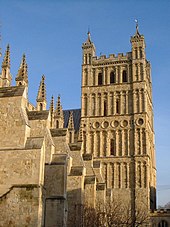
Both of the cathedral's towers contain bells. The North Tower contains an 80-hundredweight(4.1-tonne)bourdonbell, called Peter. Peter used to swing but it is now only chimed.
The South Tower contains the second heaviest peal of 12 bells hung for change ringing in the world, with a tenor weighing 72 long cwt 2 qr 2 lb (8,122 lb or 3,684 kg).[20]They are second only toLiverpool Cathedralin weight.[21]There are also twosemitonebells in addition to the peal of 12.[22]
Dean and Chapter[edit]
As of 5 December 2020:[23]
- Deanof Exeter — Jonathan Greener (since 26 November 2017 installation)
- Canon Precentor — James Mustard (since 25 March 2018 installation)
- Canon Chancellor — Chris Palmer (since 5 August 2018 installation)[24]
- Canon Steward — Cate Edmonds (SSM; (residentiary canon) since 22 October 2019 installation)[25]
- Non-Canons[26]
- Priest Vicar — Ian Morter (Canon Treasurer & Pastor 2010–2017; Priest Vicar since June 2018)
- Priest Vicar — Julian Ould
Burials[edit]
A full listing of monuments and transcription of inscriptions in the cathedral is contained in:Hewett, John William,Remarks on the Monumental Brasses and Certain Decorative Remains in the Cathedral Church of St Peter, Exeter, to which is Appended a Complete Monumentarium,published inTransactions of the Exeter Diocesan Architectural Society,Volume 3, Exeter, 1846–1849, pp. 90–138[1]
Persons buried within the cathedral include the following:
- Leofric (bishop),firstBishop of Exeter(1050–1072)
- Robert Warelwast,Bishop of Exeter (1138–1155)
- Bartholomew Iscanus,Bishop of Exeter (1161–1184)
- John the Chanter,Bishop of Exeter (1186–1191)
- Henry Marshal,Bishop of Exeter (1194–1206)
- Simon of Apulia,Bishop of Exeter (1214–1223)
- Walter Bronescombe,Bishop of Exeter (1258–1280)
- Peter Quinel,Bishop of Exeter (1280–1291)
- Henry de Bracton(c. 1210–c. 1268), English ecclesiastic andjurist
- SirHenry de Raleigh(died 1301), knight
- Walter de Stapledon,Bishop of Exeter (1308–1326)
- SirRichard de Stapledon(died 1326), knight, elder brother of Bishop Stapledon
- James Berkeley(died 1327), Bishop of Exeter
- John Grandisson,Bishop of Exeter (1327–1369)
- Hugh Courtenay, 2nd Earl of Devon(1303–1377) and his wife Margaret de Bohun (died 1391)
- Thomas de Brantingham,English lord treasurerand Bishop of Exeter (1370–1394)
- SirPeter Courtenay(died 1405), fifth son ofHugh Courtenay, 2nd Earl of Devon
- William Wilford (died 1413), Steward, Exeter Mich. 1396–7; receiver 1397–8; Member of the council of 12 1398–9, 1401–2, 1403–4, 1405–6, 1407–8, 1409–10, 1411–12; Mayor of Exeter 1400–1, 1402–3, 1404–5, 1406–7, 1408–9, 1410–11, 1412–13.
- Edmund Stafford,Lord Privy Seal,Lord Chancellor,Baron Staffordand Bishop of Exeter (1395–1419)
- Edmund Lacey,Bishop of Exeter (1420–1455), whose tomb had been a shrine, but which was walled over during the Reformation, fragments were uncovered during theBaedeker Blitz[27]
- John Speke(1442–1518) ofWhitelackington,Somerset and of Heywood in the parish ofWembworthyand ofBramford Speke,Devon (buried in theSpeke Chantry)
- Hugh Oldham,Bishop of Exeter (1504–1519; buried in theOldham Chantry)
- William Alley,Bishop of Exeter (1560–1571)
- William Bradbridge,Bishop of Exeter (1571–1578)
- John Woolton,Bishop of Exeter (1579–1594)
- Dr. William Cotton,Bishop of Exeter (1598–1621) buried in Exeter Cathedral. His monument with recumbent effigy survives.
- Ofspring Blackall(1655–1716), Bishop of Exeter (1708–1716) buried on the southern side of the choir in an unmarked grave
- John Ross(1719–1792), Bishop of Exeter (1778–1792) buried in the south aisle of the choir, the place being marked by a flat tombstone and the inscription 'J. R.,D.D.,1792.'
- Bryan Blundell (1757–1799), Major General in the Army and Lieutenant Colonel of the 45th Regiment of Foot
- Sir Gawen Carew
- Peter (Pierre) of Courtenay (1126–1183), youngest son of Louis VI of France and his second Queen consort Adélaide de Maurienne.
- SirPeter Carew(c. 1514– 1575) is not buried in the cathedral, but is commemorated by a mural monument.
- George Knight-Bruce,Bishop of Bloemfontein (1886- 1891) and first Bishop of Mashonaland (now Harare)(1891–1895) is commemorated by a memorial tablet.
-
Effigies of Hugh Courtenay, 2nd Earl of Devon, and his wife Margaret de Bohun
-
Rubbing frommonumental brassof SirPeter Courtenay,Exeter Cathedral, south aisle
-
Mural monument to SirPeter Carew,south transept
-
Wall tablet to Major-General Bryan Blundell Esq, north east chapel
-
Wall tablet commemorating George Knight-Bruce, first bishop of Mashonaland (now Harare)
Legends[edit]

One 19th-century author claimed that an 11th-centurymissalasserted thatKing Æthelstan,the previous century, had brought together a great collection of holy relics at Exeter Cathedral; sending out emissaries at great expense to the continent to acquire them. Amongst these items were said to be a little of "the bush in which the Lord spoke toMoses",and a" bit of the candle which the angel of the Lord lit in Christ's tomb ".[28]
According to the semi-legendary tale, the Protestant martyrAgnes Prest,during her brief time of liberty in Exeter before her execution in 1557, met a stonemason repairing the statues at the cathedral. She stated that there was no use repairing their noses, since "within a few days shall all lose their heads".[29]There is a memorial to her and another Protestant martyr,Thomas Benet,in theLivery Dolearea of Exeter. The memorial was designed byHarry Hemsand raised by public subscription in 1909.[30]
Wildlife[edit]
The tube web spiderSegestria florentina,notable for its iridescent shiny green fangs, can be found within the outer walls. The walls are made of calcareous stone, which decays from acidic pollution, to form cracks and crevices which the spider and otherinvertebratesinhabit.[31]
Music[edit]
Choir[edit]

Exeter Cathedral Choir is composed of 38 Choristers (boys and girls) along with Choral Scholars and Lay Vicars. There is also a voluntary choir, the St Peter's singers, dating back to 1881.[32]
Organists[edit]
Recorded names of organists at Exeter go back to Matthew Godwin, 1586. Notable organists at Exeter Cathedral include Victorian composerSamuel Sebastian Wesley,grandson of Methodist founder and hymn-writerCharles Wesley,educatorErnest Bullock,and conductorThomas Armstrong.The current Director of Music, Timothy Noon, was appointed in 2016.[33]
Organ[edit]
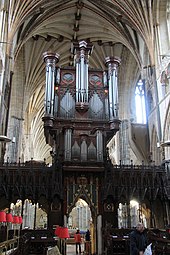
The Cathedral organ stands on the ornate medieval screen, preserving the old classical distinction betweenquireandnave.The first organ was built byJohn Loosemorein 1665. There was a radical rebuild byHenry Willisin 1891, and again byHarrison & Harrisonin 1931.[35]The largest pipes, the lower octave of the 32′ Contra Violone, stand just inside the southtransept.The organ has one of only threetrompette militairestops in the country (the others are inLiverpool Cathedraland London'sSt Paul's Cathedral), housed in theminstrels' gallery,along with a chorus ofdiapason pipes.[34]
In January 2013 an extensive refurbishment began on the organ, undertaken by Harrison & Harrison. The work consisted of an overhaul and a re-design of the internal layout of the soundboards and ranks of the organ pipes.[36]In October 2014 the work was completed and the organ was reassembled, save for the final voicing and tuning of the new instrument.[37]
See also[edit]
- Dean of Exeter
- Exeter Cathedral School
- Exeter monastery
- Myles CoverdaleBishop of Exeter, 1548–1553
- List of cathedrals in the United Kingdom
- List of Gothic Cathedrals in Europe
- Architecture of the medieval cathedrals of England
- Romanesque architecture
References[edit]
- ^"TimeRef - Medieval and Middle Ages History Timelines - Exeter Cathedral Details".timeref.Archivedfrom the original on 2 April 2017.Retrieved2 April2017.
- ^ab"Dove Details".dove.cccbr.org.uk.Retrieved2 December2018.
- ^Nalewicki, Jennifer (7 May 2024)."1,900-year-old Roman legionary fortress unearthed next to UK cathedral".Live Science.Archivedfrom the original on 9 May 2024.
- ^Erskine et al. (1988) p. 11.
- ^"Parr, Susanna (fl. 1650–1659), religious writer".Oxford Dictionary of National Biography(online ed.). Oxford University Press. 2004.doi:10.1093/ref:odnb/66714.Retrieved29 August2020.(Subscription orUK public library membershiprequired.)
- ^abcdeThe Cathedral Church of St Peter in Exeter.Printed leaflet distributed at the Cathedral. (2010)
- ^S C Carpenter (1943)Exeter Cathedral 1942.London: SPCK p. 1-2
- ^Miller, Edward (July 1982)."The Accounts of the Fabric of Exeter Cathedral, 1279–1353, I: 1279–1326. Edited translated by A. M. Erskine. (Devon & Cornwall Record Society N.S. 24.) Pp. xxi + 212. The Devonshire Press (for the Devon and Cornwall Record Society), 1981. Copies from 7 The Close, Exeter, £8".The Journal of Ecclesiastical History.33(3): 494–495.doi:10.1017/s002204690002666x.ISSN0022-0469.
- ^ab"Exeter – Tracing the Past: Medieval Vaults".Retrieved1 September2021.
- ^Russell, Georgina (1991). "Some Aspects of the Decorated Tracery at Exeter Cathedral". In Kelly, Francis (ed.).Medieval Art and Architecture at Exeter Cathedral.London: British Archaeological Association. pp. 85–93.ISBN9780901286277.
- ^Cothren, Marilyn Stokstad Michael W. (2010).Art History Portable, Book 4 14th-17th Century Art(4th ed., Portable ed.). Upper Saddle River, NJ: Prentice Hall.ISBN978-0205790944.
- ^Cothren, Marilyn Stokstad Michael W. (2010).Art History Portable, Book 4 14th–17th Century Art(4th ed., Portable ed.). Upper Saddle River, NJ: Prentice Hall. p. 554.ISBN978-0205790944.
- ^"The Exeter Misericords".Exeter Cathedral. Archived fromthe originalon 15 August 2010.Retrieved23 August2010.
- ^Addleshaw (1921) p. 36
- ^"Bagpipe Paintings: The Bagpiper of Exeter".prydein.Prydein, American Celtic-Rock.Archivedfrom the original on 31 July 2016.Retrieved17 December2016.
[photos of the Minstrels Gallery]
- ^Edmonds (1899)."The Formation and Fortunes of Exeter Cathedral Library".Report & Transactions of the Devonshire Association.106:36.hdl:2027/coo.31924106523669.
- ^Edward Edwards(1901),Memoirs of Libraries, of Museums, and of Archives(2nd ed.), Newport, Isle of Wight,OCLC3115657,OL14022288M
{{citation}}:CS1 maint: location missing publisher (link) - ^abcdLloyd, L. J. (1967)The Library of Exeter Cathedral.Exeter: University of Exeter
- ^Sayle, Charles(1916).Annals of Cambridge University Library, 1278-1900.Cambridge: University Library. p.49(footnote 3).Archivedfrom the original on 6 March 2016.Retrieved29 July2016.
- ^"Doves Guide for Bellringers".Retrieved28 July2014.
- ^"Dove's Guide Search".dove.cccbr.org.uk.Retrieved2 December2018.
- ^"Rings of 12".The Rings of 12.Archivedfrom the original on 21 February 2015.Retrieved28 July2014.
- ^Exeter Cathedral — Chapter Members(Accessed 5 December 2020)
- ^"Appointment of Canon Chancellor".Exeter Cathedral.25 March 2018.Archivedfrom the original on 30 January 2019.Retrieved30 January2019.
- ^"Cathedral News issue 691"(PDF).Exeter Cathedral.November 2019.Archived(PDF)from the original on 5 December 2020.
- ^Exeter Cathedral — Cathedral ClergyArchived16 August 2018 at theWayback Machine(Accessed 7 January 2018)
- ^Stephan, D.John (24 September 1955)."A Forgotten Shrine".The Tablet.Archived fromthe originalon 19 August 2014.Retrieved18 August2014.
- ^Jusserand, J. J. (1891)English Wayfaring Life in the Middle Ages.London: T. Fisher Unwin; p. 327.
- ^John Foxe (1887 republication),Book of Martyrs,Frederick Warne and Co, London and New York, pp. 242–44
- ^Cornforth, David."Livery Dole Martyr's Memorial".Exeter Memories.Archivedfrom the original on 6 April 2012.Retrieved17 December2011.
- ^Wild DevonThe Magazine of the Devon Wildlife Trust, pages 4 to 7 Winter 2009 edition
- ^"Exeter Cathedral Choir leads around eight services each week".Exeter Cathedral.Archived fromthe originalon 14 January 2020.Retrieved6 February2020.
- ^"Timothy Noon".[permanent dead link]
- ^ab"The National Pipe Organ Register - NPOR".npor.org.uk.
- ^"Exeter Cathedral".Harrison-organs.co.uk. Archived fromthe originalon 6 March 2012.Retrieved18 September2012.
- ^"Organ Restoration Begins".Exeter Cathedral Website.Archivedfrom the original on 22 October 2014.Retrieved14 October2014.
- ^"Cathedral organs".Exeter Cathedral website.Archived fromthe originalon 6 October 2014.Retrieved14 October2014.
Sources[edit]
- Addleshaw, Percy (1921).Bell's Cathedrals: The Cathedral Church of Exeter(New and revised ed.). G. Bell & Sons, London.Online copy
- hereatProject Gutenberg
- Erskine, Audrey; Hope, Vyvyan; Lloyd, John (1988).Exeter Cathedral - A Short History and Description.Dean and Chapter of Exeter Cathedral.ISBN0-9503320-4-6.
Further reading[edit]
- Henry, Avril K.; Hulbert, Anna C."Exeter Cathedral Keystones & Carvings: A Catalogue Raisonné of the Sculptures & Their Polychromy".Universities of Essex – History Data Service.Retrieved23 August2010.
- Barlow, Frank, et al. (1972)Leofric of Exeter: essays in commemoration of the foundation of Exeter Cathedral Library in A.D. 1072;by Frank Barlow, Kathleen M. Dexter, Audrey M. Erskine, L. J. Lloyd. Exeter: University of Exeter
- Orme, Nicholas (2009)Exeter Cathedral: the first thousand years, 400-1550.Exeter: ImpressISBN0-9556239-8-7(a history of the successive churches on the site from Roman to early Tudor times)
External links[edit]
- Official website
- THE CATHEDRAL CHURCH OF EXETER, A DESCRIPTION OF ITS FABRIC AND A BRIEF HISTORY OF THE EPISCOPAL SEE BY PERCY ADDLESHAW,, public domain on Project GutenbergArchived9 August 2016 at theWayback Machine
- Monuments in Exeter Cathedral (Church Monument Society)
- Pictures of the Minstrel's Gallery.
- A painting ofInterior of Exeter CathedralbyThomas Allomengraved by E Challis for Fisher's Drawing Room Scrap Book, 1834, as an illustration toLetitia Elizabeth Landon's poem
 The Missionary..
The Missionary..
- Exeter Cathedral
- Anglican cathedrals in England
- Benedictine monasteries in England
- Pre-Reformation Roman Catholic cathedrals
- Churches in Exeter
- Church of England church buildings in Devon
- Diocese of Exeter
- History of Exeter
- Monasteries in Devon
- Tourist attractions in Exeter
- Grade I listed cathedrals
- Grade I listed churches in Devon
- English churches with Norman architecture
- English Gothic architecture in Devon
- Grade I listed monasteries
- British churches bombed by the Luftwaffe
- Basilicas (Church of England)
- Burial sites of the Capetian House of Courtenay
- 12th-century church buildings in England



